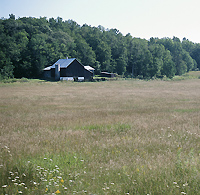Damaged Pastures Need Renovation
Damaged Pastures Need Renovation

Many Kentucky pasture fields have been battered by more than a year of tough weather conditions. Renovating these pastures by adding legumes during the next few weeks can provide many benefits.
Adding legumes such as red clover, white clover, lespedeza or alfalfa to grass fields improves production and provides a high-quality feed. In addition, legumes are able to utilize atmospheric nitrogen, reducing the need for commercial nitrogen fertilizer.
“Legume content in Kentucky pastures has been reduced dramatically as a result of drought and high temperatures in 2005 and very muddy conditions last winter,” said Garry Lacefield, forage specialist with the University of Kentucky College of Agriculture.
Renovation efforts in 2005 on many fields weren’t successful or weren’t able to be done at all because of wet weather conditions, he said. As farmers look for ways to improve their pastures in the next few months, adding legumes should be on top of their lists.
Legumes provide growth in the summer months when most of Kentucky’s grasses become nearly dormant. A mix of legumes and grasses improves the seasonal distribution of forages, Lacefield said.
In addition to improved summer production, interseeding grass pastures with legumes usually increases total yield. Many studies have shown that dry matter production and crude protein production per acre goes up when legumes are introduced.
Legumes improve overall forage quality of a grass field because of increased palatability, intake, digestibility, and protein and mineral content. While legumes are normally higher in quality than grasses, there can be a wide range within each group.
Another bonus legumes can offer is their ability to take nitrogen from the air and use it to make protein and other nitrogen-containing compounds. This allows the pasture to attain the nitrogen it needs without additional nitrogen fertilizer, and with today’s high nitrogen fertilizer prices, that is even more important, Lacefield said.
To seed legumes into existing grass pastures, many techniques will work, including simply broadcasting seeds over the ground, which allows the seed to make contact with the soil through the freeze-thaw process, and using a drill to directly plant the seed into the soil.
No matter the technique, there are some practices that will help ensure a successful renovation. These practices include grazing or mowing the grass prior to renovating. Planting into tall grass shades the legumes and reduces their growth. Be sure to soil test and properly fertilize fields but do no use nitrogen as this will increase grass growth and competition with new legume seedlings. Sow certified seed at the rates recommended and, just before seeding, inoculate with proper nitrogen-fixing bacteria if seed is not pre-inoculated.
Broadcasting seeds on top of the ground will often result in good stands if seedings are made in late winter, if the grass is extremely short and if proper fertility is applied.
Renovated fields should be kept grazed short until the livestock begin to bite off the young legumes. At that time, the cattle should be removed and the legume allowed time to become established, generally between four to eight weeks depending on the legume.
To put legumes in hay and pasture fields is one thing but keeping them is another, Lacefield noted. To do that, properly fertilize according to soil tests, manage grazing and clip pastures as needed to remove grass seed heads, control weeds and woody vegetation.
